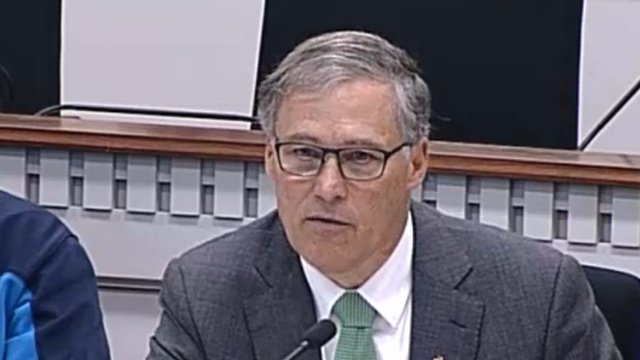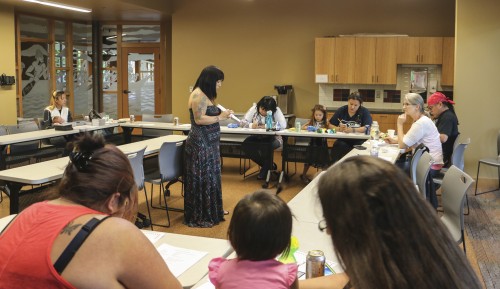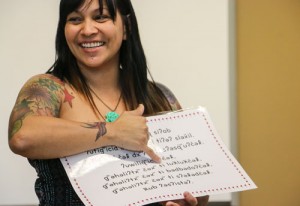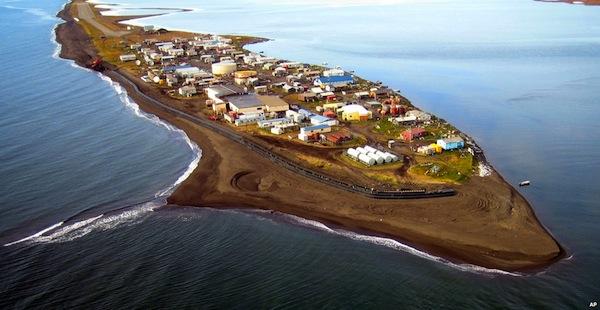Climate Disruptions Hitting More and More Tribal Nations
Native Americans have long had a close relationship with their lands and waters—sacred places and resources that define their lives. The disruptions wrought by a warming climate are forcing abrupt cultural changes on peoples with a long reliance on a once stable ecosystem.
Among the special issues affecting tribes, the 2013 Assessment of Climate Change in the Southwestern United States (SWCA) cited “cultural and religious impacts, impacts to sustainable livelihoods, population emigration, and threats to the feasibility of living conditions.”
RELATED: Climate Change Hits Natives Hardest
The Hoh, Quinault, Quileute and Makah nations inhabit low-lying land along the west coast of Washington State, and face similar threats as rising sea levels and the other impacts of climate disruptions endanger their villages.
”The area is relatively vulnerable,” Patty Glick, senior global warming specialist and author of a 2007 National Wildlife Federation report, ”Sea Level Rise and Coastal Habitats in the Pacific Northwest,” told Indian Country Today Media Network in 2008. Higher wave action, wave force and destructive storm surges will increase in the coming decade, Glick said, and destructive storms such as the hurricanes will become more frequent.
RELATED: Olympic Coast Tribes Face Rising Ocean Levels
The Hoh road to the beach has washed out, and the ocean has destroyed the homes that once lined their beach. In Quinault, a passing storm tossed gigantic logs onto the school grounds. These events intensified both tribes’ agenda to get higher ground returned from the Olympic National Park beyond their tiny reservation boundaries.
The Makah and the Quinault nations have large reservations, but their seaside villages are at risk, as evidenced by the recent state of emergency at Quinault headquarters in Taholah, which faced an increasingly dangerous situation with sea level rise and intensified storms, which breached a sea wall causing serious damage.
According to Climate Central, which uses data from NOAA and the USGS, there is a greater than one in six chance that sea level rise, plus storm surge, plus tides, will raise sea levels by more than one foot before 2020 along the coastline and in the Puget Sound region, where another eight tribes are situated. The Shoalwater Bay sits nearly out to sea in southwest Washington.
Rising sea levels will affect Washington’s shoreline habitat for vegetation, animals, birds and fish, according to Glick’s report. Marshes, swamps and tidal flats will be significantly affected, and salmon and shellfish habitat are expected to be significantly affected, Glick reported.
Along Alaska’s northwestern coast, melting sea ice has reduced natural coastal protection. Increased coastal erosion is causing some shorelines to retreat at rates averaging tens of feet per year. In Shishmaref and Kivalina, Alaska, severe erosion has caused homes to collapse into the sea, according to the Environmental Protection Agency, forcing these Alaska Native Village populations to relocate in order to protect lives and property.
RELATED: Alaskan Native Communities Facing Climate-Induced Relocation
Moving inland, “Climate change is slowly tipping the balance in favor of more frequent, longer lasting, and more intense droughts,” states the SWCA. The Navajo Nation is experiencing annual average temperatures warmer than the 1904-2011 average, cites a climate report released in March 2014. Latest figures show their drought continuing beyond 2010 studies into July 2013, indicating the drought continues.
RELATED: New Report Aims to Help Navajo Nation Cope With Climate Change
Perhaps among the worst of those impacts are the runaway sand dunes it has unleashed, which extend over one-third the 27,000-square-mile reservation. During the 1996-2009 drought period the extent of dune fields increased by some 70%. These dunes are moving at rates of approximately 35 meters per year, covering houses, burying cars and snarling traffic, degrading grazing and agricultural lands, contributing to the loss of rare and endangered native plants, and when they occur contributing to poor air quality, a serious health concern for many of the reservation’s 173,667 residents.
RELATED: Climate Change, Drought Transforming Navajo’s Dunescape to a Dust Bowl
Intertribal organizations around the U.S. are recognizing climate change and variability as a significant factor that can impact tribal resources, livelihoods, and cultures, cites the latest tribal climate report. The National Tribal Air Association notes that “perhaps no other community of people has experienced the adverse impacts of climate change more than the nation’s Indian tribes.”
The struggle will soon come to more tribes. Sea level rise projections do not bode well and may already be a cause of concern for the tribes along Louisiana’s Gulf of Mexico—the United Houma Nation, the Atakapa-Ishak Nation, Pointe-au-Chien Tribe, and the Biloxi-Chitimacha’s Isle de Jean Charles Band, Grand Caillou/Dulac Band and Bayou Lafourche Band. In Florida—the Miccosukee, and some locations of the Seminole Indian Reservations. Ocean residing tribal nations in California include the Agua Caliente Band of Cahuilla, Cahto, Chumash, Hoopa, Karok, Kumeyaay, Luiseño Bands of Indians, Maidu, Miwok, and some bands of the Pomo Nation. Some are more at risk than others.
RELATED: 6 Tribal Nations Taking a Direct Hit From Extreme Weather
Read more at http://indiancountrytodaymedianetwork.com/2014/05/07/climate-disruptions-hitting-more-and-more-tribal-nations-154747?page=0%2C1
Inslee Predicts Washington Will Adopt Controversial Fuel Standard

Austin Jenkins, NW News Network
Democratic Gov. Jay Inslee says Washington will likely adopt a California-style pollution limit on gasoline and other transportation fuels.
Inslee recently ordered a feasibility and cost study of a low-carbon fuel standard.
For months now, Washington Republicans have been predicting that Inslee will use his executive powers to enact a low-carbon fuel standard. Inslee acknowledges he’s looking at ways to do this without legislative approval. Either way he thinks Washington is poised to move forward.
“I think it’s a probability that we will be able to fashion a low-carbon fuel standard that will be effective for the state of Washington, both for carbon pollution and from a cost-containment standpoint,” Inslee said during an appearance on Seattle Channel’s “Civic Cocktail” program. “From what I know today, I think it’s a likelihood we will succeed in fashioning that, but I want reiterate we’re going to have a very sophisticated, thorough evaluation of that before I make that ultimate decision.”
A low-carbon fuel standard is basically a requirement that vehicle fuels be blended with less carbon-intensive alternative fuels. For instance, California’s standard requires a 10 percent reduction in carbon intensity of gas and diesel over 10 years.
Inslee has promised a “deliberative, public process” as he pursues carbon pollution reduction measures in Washington. Legislative Republicans oppose a fuel standard and say it could drive up the cost of gasoline.
This was first reported for the Northwest News Network.
Gathering The Stories Of Northwest People ‘Left Out’ Of History
By Tom Banse, NW News Network
It started with the discovery of long-forgotten gravestones in a thicket of bramble and alder. That set one author on the faint trail of a feisty Native American woman and oyster farmer who lived in 19th century western Washington.
The biographer is using the resulting book to inspire other Northwesterners — particularly tribal members. She wants to bring out the stories of people who, in her words, have been “left out of our histories.”
The waterfront cottage that LLyn De Danaan calls home on Oyster Bay in Mason County, Washington, overlooks a cultural crossroads rich in history. So it is fortunate she is a cultural anthropologist by profession. Her eyes and ears are tuned to signs and stories of place. And at this place, waves of settlers came from the earliest times to reap shellfish.
De Danaan moved here in the early 1970s. In recent decades, she heard enough tales about one pioneer to start a file. The name was Katie Gale. This independent businesswoman owned property and tidelands in her own name in the late 1800s.
“That was all a little bit unusual from conventional wisdom and things I had heard about both people in the oyster business and Native American women,” says De Danaan.
Finding Katie Gale
The biographer was fascinated by how Gale straddled different worlds and stood up for herself and her mixed race children.

“I suppose there just were too many things about that that intrigued me that I couldn’t let go of it,” she says. “I literally couldn’t let go of it for years!”
A turning point came when De Danaan and several friends from the historical society discovered an overgrown little homestead graveyard a mile from her house. One of the headstones belonged to Katie Gale.
“I was so amazed, excited, enthralled that I began beating on Stan’s shoulders as he was kneeling in front of me holding this stone.”
Her friend had to plead with her to contain her excitement and stop it.
“I literally said, ‘I know who this is,’ as if she were an acquaintance of mine. But it almost felt that way,” recalls De Danaan. “I would say that was a moment of calling. I have to tell this woman’s story. I have to know her.”
But here’s the problem: the long-dead Katie Gale left no letters, no journals. De Danaan could find no photographs of her, no living descendants. The best source material was a divorce case file. It took almost a decade to accumulate corroborating details, context and enough educated guesses to write a biography. “Katie Gale: A Coast Salish Woman’s Life on Oyster Bay” was published last fall.
“So many stories not told”
But the tale doesn’t stop there.
“There are so many stories not told,” says De Danaan. “There are so many histories and people left out of our histories. That is what my work has to be now. I feel that it is my obligation to do that.”
At a writing class at the Evergreen State College Longhouse in Olympia, De Danaan is a guest speaker.
De Danaan exhorts the seminar to bring forth stories before they’re lost, perhaps starting with family history. This is a message De Danaan returns to again and again in regular public talks and one-on-one mentoring.
“You’re able to find out a lot more than you think,” she says.
All of the students in the circle facing the author this day are Native American. It takes awhile, but eventually sensitivities come out.
Keeping tradition and culture alive

One student says she was hesitant about taking the class. Her grandmothers warned against exposing too much of their Spokane tribal heritage to outsiders who might twist it or exploit it.
Makah tribal member Vince Cook heard that from his elders too.
“That’s a tough one,” he says. “Because when I was younger we were told not to record, not to videotape.”
Cook says attitudes are changing now as people see tradition and culture slipping away. He feels spurred to write about his great grandmother and all the things she taught him.
“I think it is important to continue on not only for myself, but for my family and for others to know about the Makah culture and to keep it alive,” says Cook.
Another person who says author De Danaan encouraged him is amateur folklorist Si Matta of rural Pe Ell, Washington. Matta’s focus is on gathering the stories of his ancestors from the Cascade (Watala) Indian tribe who once lived and fished in the Columbia River Gorge.
He’s approaching the task in a thoroughly modern way by soliciting and sharing material and old photographs via a website and Facebook page.
Preparing for storms and natural disasters-NBSM Week 2

By Monica Brown, Tulalip New Writer
Tulalip, WA-As we move through the seasons sometimes we experience severe weather that can be exciting to watch but can also cause major property damage and put lives at risk. National Building Safety Month’s week two focuses ways to prepare your family and home for natural disasters such as earthquakes, flooding, wildfires, tornadoes, hurricanes and strong winds.
Tulalip is situated in a highly seismic area. The USGS data estimates there is a 76.62 percent chance of a major earthquake within 50km of Snohomish, within the next 50 years.And, Snohomish county data has found that Snohomish County earthquake activity is just above the Washington State average and is 268 percent greater than the U.S. average overall.
Earthquake Tips
- Make sure your home is securely anchored to its foundation
- Strap water heaters, appliances and TVs to wall studs.
- Anchor bookshelves, heavy furniture, appliances and televisions to wall studs.
- Secure pictures, mirrors and ornaments to the wall with appropriate fasteners.
- Know where and how to shut off electricity, gas, and water services.
Washington is one of the more flood-prone states in the nation. According to the Department of Ecology Washington State, from 1980 to 2011, Washington had 22 Presidentially-declared flood disasters.
Flooding Tips
- Elevating your home above the base flood elevation (the elevation associated with the “100-year flood”) is the best method of protecting your home, and is a requirement for new homes. Visit flash.org for more information.
- Wet flood proofing your home allows flood water to flow through the structure. An example of wet flood proofing is installing flood vents that create permanent openings in the foundation.
- Dry flood proofing your home prevents floodwaters from entering the building. An example of dry flood proofing is installing new brick veneer over asphalt coating and applying polyethylene film over existing walls.
According to the Washington Military Department Emergency management Division, an average of 900 wildfires are started annually throughout Washington state with 70% of them occurring in eastern Washington.
Wildfire Tips
- Prevent wildfire damage by developing a defensible space in your landscaping by clearing at least 30 feet around your home, or 50 feet around your home if you reside in a heavily wooded area.
- Plant fire-resistant, native vegetation and remove any dead or dying trees. Properly prune shrubs, and trim tree branches so they don’t extend over a roof or near the chimney. Mow your grass and control the height and spread of ground covering vegetation. Keep plants at least 12 to 18 inches away from the house.
- When putting on a new patio deck, build from fire-resistant materials. On new and existing decks, create fire barriers around the deck base and clear vegetation at least 100 to 300 feet downhill from the deck base.
- Install only burning-brand, exposure rated (Class A, B or C) roof assemblies using materials such as asphalt shingles, slate or clay tile or metal roof coverings.
Hurricanes are a tropical storm and most likely will never happen in Washington State, unless there is a major climate shift that places the state in a tropical zone. But, tornadoes and strong winds comparable to hurricane winds can and do happen in Washington. Tornadoes happen once or twice a year in Washington yet have weak winds that are barely strong enough to do much damage. But it is still a good idea to make sure your home, roof and windows can withstand strong winds.
Hurricanes, Tornadoes and Strong Winds Tips
- The best place to start is with a Do-It-Yourself Wind Inspection (can be found on Flash.org) to find out what is ok with your house and what needs attention.
- Improve your roof’s resistance to uplift by applying a 1/4 -inch bead of caulk of along the intersection of the roof deck and the roof support element (rafter or truss chord) on both sides with a caulking gun.
- If your home is not protected by impact-resistant windows and doors or impact-resistant shutters or panels, consider building your own temporary emergency panels.
To help Homeowners weather a severe storm or natural disaster, NBSM suggests that you:
- Develop a family disaster plan that includes a list of food and water supplies needed for each member of your family and supplies for your pets. Make copies of important documents like insurance policies, the deed to your home, and other personal papers, important phone numbers and a home inventory. Create a checklist of important things to do before, during and after a disaster.
- Review your evacuation route and emergency shelter locations with your family. Options for evacuation would include staying with friends and relatives, seeking commercial lodging, or staying in a mass care facility operated by disaster relief groups in conjunction with local authorities.
- Taking shelter is critical in times of disaster. Sheltering in place is appropriate when conditions require that you seek protection in your home, place of employment, or other location where you are when disaster strikes.
Tulalip Community Development has detailed informational handouts that can be picked up at the Tulalip Administration building or contact Orlando Raez at 360-716-4214.
For more information about NBSM or Disaster Preparedness please visit www.iccsafe.org and www.flash.org. All tips from the National Building Safety Month.
10 Important Tips to remember for disaster safety and mitigation
Develop a family action plan and share with everyone in your family, so you will know where to go if an evacuation is called. Review at least two exit routes from your home or neighborhood to a designated meeting place for your family. Plan ahead for your pets as many shelters will not accept them.
Create a disaster supply kit that will allow you to remain in your home after a disaster or for use after evacuating to a safer location. Be sure the necessities in your kit are fresh and restored every six months.
Stay tuned to radio, TV and NOAA Weather Radio for official updates and critical lifesaving weather information. Remember, reception is usually best if placed near a window.
Flooded roads could have significant damage hidden by floodwaters. Never drive through floodwaters or on flooded roads. Do not attempt to cross a flowing stream. It takes only six inches of fast flowing water to sweep you off your feet and two feet of water to move an SUV-sized vehicle.
If you live in a high wind or hurricane prone area and do not have tested and code approved shutters for protection from windborne debris, temporarily protect your doors and windows by mounting exterior grade, 5/8″ minimum thickness plywood and fastening it into place. Visit www.flash.orgfor detailed instructions on how to use plywood for emergency board up.
Secure lawn furniture and any other loose outdoor items that can become windborne and can cause injury or damage during storms with high winds. Don’t forget trash cans, grills, toys and potted plants.
Consider building or retrofitting to create a tornado safe room in your home. Follow ICC/NSSA 500 Standard for detailed construction information and to ensure you achieve the highest level of protection for your family.
Use Surge Protective Devices (SPD) in your home to protect electronic appliances from all but the most severe electrical surges or direct strikes. The devices should be installed to afford the highest level of protection.
In wildfire prone areas, remove fine (dead grass, leaves, etc.) and coarse fuels (dead twigs, branches, etc.) within 30 feet of a building to create a survivable space in case of wildfire. Be sure to remove dry leaf and pine litter from roofs, rain gutters, decks and walkways. Follow ICC’s International Wildland-Urban Interface Code for detailed requirements.
Before a winter storm, insulate all exposed water pipes outside the home. It is important to allow a slow trickle of water to flow during a winter freeze especially if the faucet is on an exterior wall. Remember, wrap and drip your pipes for the ultimate protection in a freeze.
Source: www.iccsafe.org
Make Mother’s Day Extraordinary: Huckleberry Muffins
Happy Mother’s Day, Mom! I don’t think I’ve ever told you how much it meant to me when you’d wake up early to make us muffins in the winter. It’s one of my favorite childhood memories. Thank you and I love you.
Huckleberries are an important and much loved berry of the Pacific Northwest. They’re “in season” for only one or two weeks of the late summer and they don’t grow just anywhere. In fact, part of their appeal is that they refuse to be domesticated. Scientists/botanists have tried to domestic the plant to no avail. Thus, if you want to enjoy the ruddy purple berry you have little choice but to pack a picnic, pack the kids, and head to the mountains to find a good patch.
In the late summers my own family would spend an afternoon picking in our own carefully scouted secret patch. Mom would pack a picnic of peanut butter and jelly sandwiches while dad clumsily lathered his three daughters in sunscreen. Then we headed up Vulcan Mountain in search of treasure. The car carefully wound up the dusty dirt road as we climbed out of the Curlew Valley to over 5,000 feet above sea level. We’d eat at least as many berries as we picked but somehow we’d still manage to come home with two or three gallons of huckleberries. Some of the berries were used immediately as topping for shortcake or ice cream. The rest were placed in the freezer to be made into jam or to be carefully rationed out over the winter.
Because, you see, winter in the Northwest kind of sucks. And huckleberries were my mother’s secret winter-morning weapon.
Six-thirty in the morning never comes easily when daylight is still an hour away and at a time of year when daylight doesn’t guarantee sunlight—for days. Toss in a school morning and you have a recipe for three little girls who will fight to stay in bed under the warm covers. Mom usually had to threaten us out of bed on such mornings, but on the occasional Northwest winter morning—we never had advanced warning—my sisters and I would wake up to the smell of something glorious baking.
Something extraordinary to start an ordinary, cold, dark, and harsh winter morning.
And in the place of threats, negotiations, mumbles and grumbles, in the place of cold cereal or oatmeal, the cold and dark morning would become punctuated with the sound of three sets of excited little feet racing to the kitchen, shouting: “Get up! Get up! Mom’s making muffins!”
And there was never any doubt as to what kind of muffins they’d be, for there was only one kind: Huckleberry.
And 6:30 a.m. would become easy. Treasured. Magical. Nothing could go wrong, the weather be too cold, the morning too dark, on huckleberry muffin mornings.
To me, early morning batches of huckleberry muffins are still an ultimate expression of love, devotion, and solidarity in that, hey, sometimes it’s hard to get out of bed. And they’re one of my most treasured childhood memories. So if I happen to get up extra early, no matter the season, and if I happen to offer you a cup of my precious winter stash of huckleberries in a batch of muffins, then you should know that I love you. Dearly.
And I want your day to be extraordinary.
Bonnie’s Huckleberry Muffins
Make these for your mom as the perfect breakfast-in-bed treat! Makes 12 muffins
Preheat oven to 400 degrees
1 c. oatmeal
1 c. milk
1 egg
¼ c. oil
1 c. flour
1/3 c. sugar
2 t. baking powder
¼ t. salt
1 c. huckleberries (or blueberries/raspberries/strawberries)
Combine oatmeal, milk, egg, and oil. Set aside for 15 minutes.
Combine flour, sugar, baking powder and salt. Make a well in the center of dry ingredients. Add oat/milk mix until moist, mix will be lumpy.
Bake 18-20 minutes.
Darla Antoine is an enrolled member of the Okanagan Indian Band in British Columbia and grew up in Eastern Washington State. For three years, she worked as a newspaper reporter in the Midwest, reporting on issues relevant to the Native and Hispanic communities, and most recently served as a producer for Native America Calling. In 2011, she moved to Costa Rica, where she currently lives with her husband and their infant son. She lives on an organic and sustainable farm in the “cloud forest”—the highlands of Costa Rica, 9,000 feet above sea level. Due to the high elevation, the conditions for farming and gardening are similar to that of the Pacific Northwest—cold and rainy for most of the year with a short growing season. Antoine has an herb garden, green house, a bee hive, cows, a goat, and two trout ponds stocked with hundreds of rainbow trout.
Read more at http://indiancountrytodaymedianetwork.com/2014/05/10/make-mothers-day-extraordinary-huckleberry-muffins-154752
International Team Maps Nearly 200K Glaciers in Quest of Sea-Level Rise Estimates

University of Colorado-Boulder May 7, 2014.
An international team led by glaciologists from the University of Colorado Boulder and Trent University in Ontario, Canada has completed the first mapping of virtually all of the world’s glaciers — including their locations and sizes — allowing for calculations of their volumes and ongoing contributions to global sea rise as the world warms.
The team mapped and catalogued some 198,000 glaciers around the world as part of the massive Randolph Glacier Inventory, or RGI, to better understand rising seas over the coming decades as anthropogenic greenhouse gases heat the planet. Led by CU-Boulder Professor Tad Pfeffer and Trent University Professor Graham Cogley, the team included 74 scientists from 18 countries, most working on an unpaid, volunteer basis.
The project was undertaken in large part to provide the best information possible for the recently released Fifth Assessment of the Intergovernmental Panel on Climate Change, or IPCC. While the Greenland and Antarctic ice sheets are both losing mass, it is the smaller glaciers that are contributing the most to rising seas now and that will continue to do so into the next century, said Pfeffer, a lead author on the new IPCC sea rise chapter and fellow at CU-Boulder’s Institute of Arctic and Alpine Research.
“I don’t think anyone could make meaningful progress on projecting glacier changes if the Randolph inventory was not available,” said Pfeffer, the first author on the RGI paper published online today in the Journal of Glaciology. Pfeffer said while funding for mountain glacier research has almost completely dried up in the United States in recent years with the exception of grants from NASA, there has been continuing funding by a number of European groups.
Since the world’s glaciers are expected to shrink drastically in the next century as the temperatures rise, the new RGI — named after one of the group’s meeting places in New Hampshire — is critical, said Pfeffer. In the RGI each individual glacier is represented by an accurate, computerized outline, making forecasts of glacier-climate interactions more precise.
“This means that people can now do research that they simply could not do before,” said Cogley, the corresponding author on the new Journal of Glaciology paper. “It’s now possible to conduct much more robust modeling for what might happen to these glaciers in the future.”
As part of the RGI effort, the team mapped intricate glacier complexes in places like Alaska, Patagonia, central Asia and the Himalayas, as well as the peripheral glaciers surrounding the two great ice sheets in Greenland and Antarctica, said Pfeffer. “In order to model these glaciers, we have to know their individual characteristics, not simply an average or aggregate picture. That was one of the most difficult parts of the project.”
The team used satellite images and maps to outline the area and location of each glacier. The researchers can combine that information with a digital elevation model, then use a technique known as “power law scaling” to determine volumes of various collections of glaciers.
In addition to impacting global sea rise, the melting of the world’s glaciers over the next 100 years will severely affect regional water resources for uses like irrigation and hydropower, said Pfeffer. The melting also has implications for natural hazards like “glacier outburst” floods that may occur as the glaciers shrink, he said.
The total extent of glaciers in the RGI is roughly 280,000 square miles or 727,000 square kilometers — an area slightly larger than Texas or about the size of Germany, Denmark and Poland combined. The team estimated that the corresponding total volume of sea rise collectively held by the glaciers is 14 to 18 inches, or 350 to 470 millimeters.
The new estimates are less than some previous estimates, and in total they are less than 1 percent of the amount of water stored in the Greenland and Antarctic ice sheets, which collectively contain slightly more than 200 feet, or 63 meters, of sea rise.
“A lot of people think that the contribution of glaciers to sea rise is insignificant when compared with the big ice sheets,” said Pfeffer, also a professor in CU-Boulder’s civil, environmental and architectural engineering department. “But in the first several decades of the present century it is going to be this glacier reservoir that will be the primary contributor to sea rise. The real concern for city planners and coastal engineers will be in the coming decades, because 2100 is pretty far off to have to make meaningful decisions.”
Part of the RGI was based on the Global Land Ice Measurements from Space Initiative, or GLIMS, which involved more than 60 institutions from around the world and which contributed the baseline dataset for the RGI. Another important research data tool for the RGI was the European-funded program “Ice2Sea,” which brings together scientific and operational expertise from 24 leading institutions across Europe and beyond.
The GLIMS glacier database and website are maintained by CU-Boulder’s National Snow and Ice Data Center, or NSIDC. The GLIMS research team at NSIDC includes principal investigator Richard Armstrong, technical lead Bruce Raup and remote-sensing specialist Siri Jodha Singh Khalsa.
NSIDC is part of the Cooperative Institute for Research in Environmental Sciences, or CIRES, a joint venture between CU-Boulder and the National Oceanic and Atmospheric Administration.
– See more at: http://www.colorado.edu/news/releases/2014/05/06/international-team-maps-nearly-200000-glaciers-quest-sea-level-rise#sthash.W6vK18yo.dpuf
Walking for a cause: local women join the Warriors in Pink

Photo/ Brandi N. Montreuil, Tulalip News
By Brandi N. Montreuil, Tulalip News
TULALIP – Donning pink with a purpose! Tulalip citizen Tawyna Cortez, and teammate Trisha Montero-Higginbotham, will participate in the Susan G. Komen 3-Day event, Walk for a Cure.
On September 19-21 they will tackle 60 miles in 3 days. Their walk begins at the Seattle Center, finishing at the Memorial Stadium at Seattle Center. Their motivation? Women close to their heart.
“I joined this adventure for two women that touched my life,” said Cortez, who is currently fundraising for the three-day walk. “My high school friend was diagnosed [with breast cancer] right after graduation. She didn’t survive her battle. The other is my grandmother who is a survivor of 17 years. She is an amazing woman to me. These two women are the reason I walk and hope to find a cure. Because no child should have to be raised without a mother, grandmother, aunt, friend, or family member that has been taken by this horrible disease. So I walk for those that are not with us or unable to walk.”
Montero-Higginbotham, whose family history includes cancer in a variety of forms, is walking in support of her aunts.
“In January I decided I would take this journey in memory of my Auntie Sylvia Montero. She was an advocate, patient educator and role model for Alaska Natives and Native Americans living with cancer. She lost her battle with the disease in October 2003. In February of this year I found out my Auntie Pat Antioquia, who has been a survivor, has had her cancer return. There isn’t a reason I shouldn’t walk this walk, so I signed up,” explains Montero-Higginbotham in her Susan G. Komen fundraising page.
Cortez and Montero-Higginbotham, are joined by Montero-Higginbotham’s husband Rob, are each trying to raise $2,300 for a total of $6,900, for the Kindred Spirits team they will be walking with. So far they are halfway there, but are still in need of donations. The money raised will go to support breast cancer research, training, and education outreach.
Last year $3.3 million was raised at the Seattle Komen 3-day walk. According to BreastCancer.org in 2013, an estimated 232,340 new cases of invasive breast cancer were expected to be diagnosed in women in the U.S., along with 64,640 new cases of non-invasive (in situ) breast cancer.
So far Kindred Spirits have put in 70 miles of training with an average of 6.5 to 8.5 miles walked a day. By the time of the 3-day walk the team will have walked an approximate 580 training miles.
You can donate to Cortez and Montero-Higginbotham by going to their individual pages at www.the3day.org. To find their pages, click on the “Donate Today” tab and search Tawnya Cortez or Trisha Montero-Higginbotham.
Brandi N. Montreuil: 360-913-5402; bmontreuil@tulaliptribes-nsn.gov
Indian rights activists say treaties give them a say on pipeline route

By David Shaffer, Star Tribune
In a new battlefront over energy policy, American Indian rights attorneys argued Wednesday before a Minnesota judge that historic treaties give tribes a say in where to build crude oil pipelines across land ceded by the Chippewa in the 19th century.
“Everybody has kind of forgotten what our rights are, and that is why we are here,” Frank Bibeau, an attorney for the Indian nonprofit group Honor the Earth, told an administrative law judge at a hearing in St. Paul.
Honor the Earth says the proposed $2.6 billion Sandpiper crude oil pipeline across northern Minnesota will produce “inevitable oil spills and environmental degradation” on ceded lands. Spills could endanger Rice Lake near McGregor and Sandy Lake in Aitkin County where Indians gather wild rice, the group says.
For the first time in Minnesota, Indian rights attorneys are arguing that the state Public Utilities Commission (PUC) lacks unilateral authority to approve pipelines. They want the state to reject the proposed route of the Sandpiper pipeline from North Dakota, and have offered an alternative path.
Enbridge Energy’s preferred pipeline route goes southeast from Clearbrook, Minn., passing west of Park Rapids and then heading east to Superior, Wis. It avoids Indian reservations, but passes through ceded lands on which Chippewa bands retain the right to fish, hunt and gather rice.
Attorneys for the company contend that the commission has no business deciding the meaning of federal treaties. Even so, much of the two-hour discussion before Judge Eric Lipman focused on 10 treaties signed between 1825 and 1864 by Minnesota Indian tribes.
“It would represent a dramatic departure from the commission’s precedent and would significantly impact not just pipeline projects but all large energy projects sited in northern Minnesota,” said Christine Brusven, an attorney for the Calgary-based pipeline company that’s proposing to build the 610-mile pipeline to carry North Dakota oil.
Headed for the courts?
Lipman, who is overseeing the regulatory review of the pipeline, is expected to rule on the treaty rights question, but the final decision rests with the Public Utilities Commission. The issue ultimately could land in federal court.
Before the hearing, about 45 Honor the Earth supporters, led by the group’s leader Winona LaDuke, demonstrated outside the PUC’s office.
Some Minnesota tribes have successfully asserted off-reservation rights under 19th century treaties. The U.S. Supreme Court in 1999 affirmed that the Mille Lacs Band of Chippewa and seven other Chippewa bands retained hunting, fishing and gathering rights under an 1837 treaty on lands and lakes ceded by the tribes in central Minnesota, including Lake Mille Lacs.
Similar rights have been recognized under other treaties, and state and tribal governments share responsibility for game management in some ceded areas. This year, the Fond du Lac Band of Chippewa is exercising rights under an 1854 treaty to spear walleyes in several lakes in northeastern Minnesota’s Arrowhead region.
Honor the Earth attorneys contend that the 19th century treaties and early 20th century court rulings about wild rice reserves give the Ojibwe a present-day right to help make decisions affecting treaty-related resources.
“We are not saying we have an absolute veto,” Bibeau said in an interview.
Cooperation sought
Prof. Peter Erlinder of William Mitchell College of Law, who also represents Honor the Earth, said various treaties “need to be accommodated by state regulatory activities.” He said the state and tribes need to find a way to cooperate on pipeline siting.
But Enbridge attorney Randy Thompson, who represented Lake Mille Lacs landowners in the 1999 case, said Honor the Earth overstates the reach of the landmark decision.
“It is a nonexclusive right to hunt and fish,” Thompson said. “It gives bands the ability to self-regulate hunting and fishing by band members. It doesn’t give bands co-management authority. It doesn’t give the bands the ability to regulate nonmembers.”
Legal experts say protection of natural resources under 19th century Indian treaties is an emerging area of law.
“We have very little idea where it is going to go,” said James Coleman, an assistant professor of energy law at the University of Calgary and Haskayne School of Business.
In the state of Washington, a tribe with rights to fish for migrating salmon has successfully argued that the state Transportation Department must repair hundreds of culverts that block the passage of fish. Federal judges, most recently in 2013, have ruled that the barrier culverts violate treaty promises. Another federal judge in that state upheld in 1996 the U.S. Army Corps of Engineers’ right to deny a permit for a fish farm because it conflicted with the Lummi Nation’s treaty fishing rights.
Most treaty cases have been decided in federal court. Honor the Earth’s legal battle is unusual because it’s in a state regulatory proceeding. Bibeau said he reserves the right to take the case to tribal or federal court later.
Two precedents
In two previous Minnesota utility cases, tribes tried unsuccessfully to assert tribal authority over proposed pipelines or power lines. In 2011, the Leech Lake Band of Ojibwe objected to a proposed transmission line that skirted tribal lands, but lost in federal court. The Fond du Lac Band of Lake Superior Chippewa objected to another pipeline in 2007. That project, like the transmission line, eventually won approval of the PUC.
Coleman, who grew up in the Twin Cities, said Indian activists face a difficult legal battle in the pipeline case. Unlike the Washington cases, he said, where judges saw actual harm to treaty-protected resources, the Minnesota concerns are about a potential situation, and depending on how bad the disaster was, maybe at some point it could eliminate those treaty rights.
New old way of learning

Photo/ Brandi N. Montreuil, Tulalip News
A family approach to Lushootseed language
By Brandi N. Montreuil, Tulalip News
TULALIP – Tulalip Lushootseed Family Night began their summer series on Wednesday, May 7. The informal classes, held weekly until July at the Hibulb Cultural Center are designed to encourage daily Lushootseed use in the home via basic words or phrases, such as “good morning, how are you” and “clean your room.”
Curriculum is based on participant requests and sections of the Lushootseed Language 101 college course through Northwest Indian College.

Photo/ Brandi N. Montreuil, Tulalip News
“Anyone is welcome to attend whether Tulalip tribal member or not. There is no age limit and although we call it Family Night, anyone is welcome to attend,” said Natosha Gobin, Tulalip Lushootseed teacher.
Through the use of crafts, storytelling, songs and games, kids are able to learn the same curriculum as the adult participants, this helps encourage fluency in the household.
“The classes are laid back and intended to empower the speakers within ourselves,” said Gobin, who stresses that participants needn’t fear mispronunciation or fear of learning the language. “Our goal is to find the best ways to bring Lushootseed into the home.”
Lushootseed Family Nights are held Wednesday’s at 5:00 p.m. to 7:00 p.m. in the Hibulb Cultural Center classrooms. Materials and lessons are free of cost, and dinner is provided.
For more information on the Family Nights or the Lushootseed language, please contact Natosha Gobin at 360-716-4499 or ngobin@tulaliptribes-nsn.gov, or visit the website www.tulaliplushootseed.com. You can also download the Lushootseed Phrases app on Android devices on the Play Store.
Brandi N. Montreuil: 360-913-5402; bmontreuil@tulaliptribes-nsn.gov













